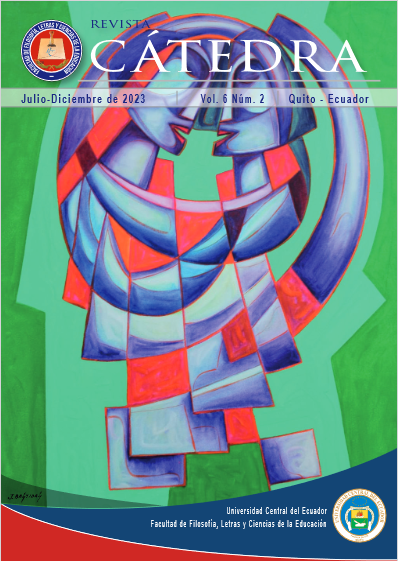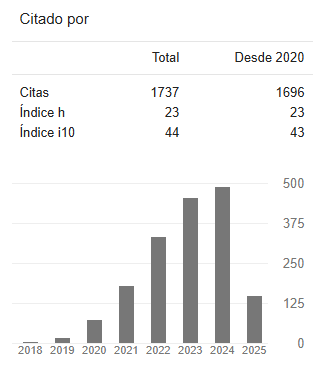E-book: a gamified didactic resource for learning Natural Sciences
DOI:
https://doi.org/10.29166/catedra.v6i2.4481Keywords:
E-book, teaching and learning, teaching resource, academic performance, ICTAbstract
This research responds to the need to improve teaching and learning processes through the use of Information and Communication Technologies (ICT), as a reality of the low use of technological tools by teachers in the classrooms, with this background, the application of the e-book as a gamified didactic resource in the ninth years of the Instituto Nacional Mejía was proposed. The methodology is quasi-experimental, consisting of two groups: 135 students in the experimental group (GE) and 115 in the control group (GC). A pretest and posttest were used with a questionnaire validated through expert judgment; Cronbach's alpha was 0.80, which proves the reliability of the questionnaire. The data of the activities developed were processed through the T test, allowing to reject the null hypothesis by having a p (value) less than 0.05 in the arithmetic means of the pretest and posttest, graphic organizers and workshops, the final decision was to reject the null hypothesis and accept the alternative hypothesis, which mentions the gamified didactic resource e-book that allows improving the teaching and learning processes, and achieving a higher academic performance in Natural Sciences in the experimental groups. The results were relevant as they significantly improved the interest and motivation of the students to learn, directly influencing their academic performance, which was demonstrated in the averages obtained: the GE reached an increase of up to 4 points as opposed to the GC, which decreased one point when performing the activities in a traditional way.
Downloads
References
Chango, W., y Sailema, M. (2017). “Recursos didácticos interactivos.” http://repositorio.utc.edu.ec/bitstream/27000/4087/1/T-UTC-0300.pdf
Caparrós, M. (2017, octubre). Gamificación en educación: una guía práctica. Recuperado el 18 de Junio de 2023, de https://www.trespuntoelearning.com/gamificacion-en-educacion-guia-practica/
Falco, M. (2017). Reconsiderando las prácticas educativas: Tics en el proceso de enseñanza-aprendizaje. Tendencias Pedagógicas, 29(2017), 59–76. https://doi.org/10.15366/TP2017.29.002
Giménez, M. (Noviembre de 2016). Ventajas y desventajas de la gamificación (entrada blog). Recuperado el 18 de Junio de 2023, de http://maritagimenez.blogspot.com/2016/11/ventajas-y-desventajas-de-la.html
Guerrero, Y. (2016, mayo). Los weblogs como recursos didácticos en el manejo de la tabla periódica de los estudiantes de primero de bachillerato de la Unidad Educativa Particular bilingüe “María Magdalena” período lectivo 2015-2016. http://www.dspace.uce.edu.ec/bitstream/25000/8802/1/T-UCE-0010-1534.pdf
Hernández, M. (2016). Diseño de e-book "Góru, el mágico”. Universidad Iberoamericana Puebla Repositorio Institucional http://repositorio.iberopuebla.mx. http://hdl.handle.net/20.500.11777/2119http://repositorio.iberopuebla.mx/licencia.pdf
Medina, R. (2017). Uso del eBook en el aula. Un medio introductorio en el manejo de las tecnologías emergentes | Medina Rodríguez | Revista de Investigación Educativa del Tecnológico de Monterrey. https://rieege.mx/index.php/rieege/article/view/183/325
Moreira, M. A., y González, C. S. G. (2015). De la enseñanza con libros de texto al aprendizaje en espacios online gamificados. Educatio Siglo XXI, 33(3 Noviembre), 15–38. https://doi.org/10.6018/J/240791
Moya, A. (2009, septiembre). https://archivos.csif.es/archivos/andalucia/ensenanza/revistas/csicsif/revista/pdf/Numero_24/ANTONIA_M_MOYA_1.pdf. https://archivos.csif.es/archivos/andalucia/ensenanza/revistas/csicsif/revista/pdf/Numero_24/ANTONIA_M_MOYA_1.pdf
Ortiz-Colón, A. M., Jordán, J., y Agredai, M. (2018). Gamification in education: An overview on the state of the art. Educacao e Pesquisa, 44. https://doi.org/10.1590/S1678-4634201844173773
Peña, A., y Calmaestra, J. (2007, enero). (PDF) Las TICs como recurso innovador en el aprendizaje presencial. https://www.researchgate.net/publication/50862217_Las_TICs_como_recurso_innovador_en_el_aprendizaje_presencial
Posada, R. (2014). La lúdica como estrategia didáctica. Universidad Nacional de Colombia https://repositorio.unal.edu.co/bitstream/handle/unal/47668/04868267.2014.pdf?sequence=1&isAllowed=y#:~:text=La%20l%C3%BAdica%20se%20toma%20entonces,juego%20y%20del%20accionar%20l%C3%BAdico
Rodríguez, E. (2009, noviembre). Ventajas e inconvenientes de las tics en el aula. https://www.eumed.net/rev/ced/09/emrc.htm
Rodríguez, R. M. (2017). Uso del eBook en el aula. Un medio introductorio en el manejo de las tecnologías emergentes. Revista de Investigación Educativa Del Tecnológico de Monterrey, 8(15), 34–40. https://www.rieege.mx/index.php/rieege/article/view/183
Zambrano-Álava, A. P., Lucas-Zambrano, M. D. L. Á., Luque-Alcívar, K. E., y Lucas-Zambrano, A. T. (2017). La Gamificación: herramientas innovadoras para promover el aprendizaje autorregulado. Dominio de Las Ciencias, 6(3), 349–369. https://doi.org/10.23857/DC.V6I3.1402









